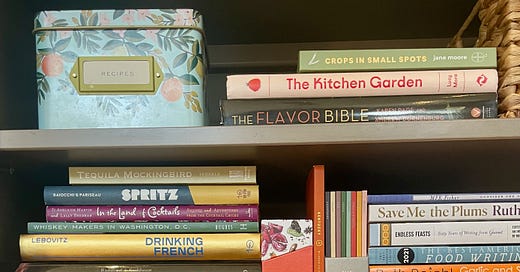My house smells permanently like cookies. My blood sugar may at this moment be spiking. The cookie bracket is well underway, and if you’re here only for the sweets and not at all for my writing, scroll to the bottom to find out how you can get a box of cookies in the mail.
Mimi Sheraton, the first woman to be the New York Times’ food critic, became active on Twitter late in 2014, right before her final book, “1,000 Foods To Eat Before You Die,” was published. She was 88, and at first, she stuck to replies and retweets of book reviews. Then, in 2019, she sent a tweet for all the world to see: a reflection on the death of 96-year-old Leah Chase, the legendary Creole chef in New Orleans.
A few days later, there was a more hopeful note: “With favorite restaurants closing, hooray for stunning revival of Pastis in Meatpacking.” A few days after that, bad news again: the death of Molly O’Neill, a food writer decades younger than Sheraton. As 2019 became 2020, as the world as we knew it ended and then kept going, Sheraton, by then well into her 90s, ruminated on Twitter about more endings and demises: Dean and Deluca, the actor Marshall Efron, an editor, friends, colleagues. By the fall of 2021, she was giving out pithy advice about late-season produce, and a tip about mashed potatoes around Thanksgiving was her final bit of Twittered wisdom.
Sheraton, who was known for wearing disguises while reviewing restaurants for the Times, died earlier this month, and as I read her obituary, I found myself laughing and smiling and wishing I hadn’t gone so long knowing so little about her. She seemed to have loved the same simple things I love: to eat, to write, to walk. She hoarded the same two things I can’t help but hoard: books and plants.
“In her Greenwich Village townhouse, Ms. Sheraton had 2,000 cookbooks and a spacious kitchen overlooking a backyard where she grew chives, tarragon, mint, sage, rosemary and basil.”
Over the past few weeks, I’ve read everything I could about her and by her — including her Twitter feed, which I was astonished to learn existed. This woman, whose New York Times copy was hammered into a typewriter, decided to beam her thoughts, 280 characters at a time, into a morass of millennials and egg avatars. There was something so hopeful about the idea of it, even if the substance was mostly doom and endings and the promotion of a book with a premise based entirely on human mortality.
I got my first journalism job in 2011, back when the newspaper people were astounded to learn they’d messed up by giving away everything for free on the internet, and for most of my career, I’ve wasted a lot of time wishing I was writing in a different time. So I guess I shouldn’t be surprised that I latched on to the dreariest interpretation of all of this: Mimi Sheraton is gone, and what she did is dying, too.
Except maybe not.
As I’ve descended deeper into my obsession with food making and reading and eating and writing over the past couple of years, I’ve gone through similar periods of obsession with other writers’ and chefs’ canons. In 2021, I read all of Ruth Reichl’s books. After that, I tore through M.F.K. Fisher’s “Consider the Oyster” twice in the span of three weeks, and I’m still making my way through the rest of her work. I also dusted off my copy of “Mastering the Art of French Cooking” and started reading it — not to cook, but just for the words. I watched “Julia,” the HBO Max show about Julia Child, then started buying episodes of “The French Chef” on Amazon Prime and watching them when I couldn’t sleep. Now I’m halfway through HBO’s show about a cooking school operating out of La Pitchoune, the Childs’ vacation home in the south of France.
I think I’m particularly drawn to these women because they viewed cooking and eating — and writing about cooking and eating — through the least fussy of lenses. To varying degrees, they operated in fields that were heavily male and dominated by people with traditional training who believed things should be done a certain way, and they politely said no thank you. Julia Child stomped around France, this tall, gawky, most American of women, and learned to cook as well as the best chefs there — and then she came back to the United States and positively pestered a bunch of feckless men to put her on TV. Ruth Reichl and Mimi Sheraton reviewed all kinds of restaurants their predecessors at the Times wouldn’t have even noticed while walking by. Mary Frances Fisher wrote lyrically about food using an androgynous pen name, at a time when most Americans were borderline disdainful about cooking as anything more than a means to an end.
And their work, from the 1930s, the ’60s, the ’70s, the ’90s — it all stands the test of time. Today, good writing about food and thoughtful recipes still have homes, though it may not be in newsprint, and some of the best cooking magazines may now be defunct. Reichl authors the first Substack I ever subscribed to, where she marries nostalgia (old restaurant menus!) with her experiences cooking and eating. HBO is drunk on all things Julia Child nearly 20 years after her death. Sure, there are now a couple thousand food TikTokers all recommending the same $21 smoothie while holding it in front of the same plant wall, but I like to think there’s still a certain reverence for restaurant critics and cookbook authors, for thinking about food and tasting it and getting all tangled up in the emotions and memories taste evokes. I teach a college class, and this semester, one of my students, oozing Gen Z in flared pants and platforms, asked me with hushed reverence if I’d ever met Tom Sietsema.
Maybe that’s part of what appeals to me about food writing: the way it transcends the year or the medium, the way the objective stays the same. We want to taste delicious things and tell everyone else how they can get in on the gluttony.
I can picture Mimi Sheraton’s herb garden in Greenwich Village, and in my imagination, it looks just a little bit like my own back patio on Capitol Hill; when I think about her 2,000 cookbooks, I see the shelves in my kitchen and dream about covering a whole wall with them. These women in food who did (and are still doing) it right — who ate until they were full and then some, who put care into their opinions and then shared them without apologizing — set a standard it’s still possible to aspire to, even as journalism chases its tail and restaurants close and square constellations of dots replace paper menus and an egg comes closer and closer to costing as much as a truffle.
The cookie bracket is underway, and with three matchups complete, there have been zero surprises. Smitten Kitchen’s salted chocolate chunk cookies defeated the crispy chewy chocolate chip cookies (also from Smitten Kitchen) pretty soundly. I baked the crispy chewy batch first, and after my first warm bite of a cookie that was somehow both crispy and chewy at the same time, I thought this whole enterprise might start out with an upset. It turns out that it’s hard to take a bad bite of chocolate chip cookie, meaning that even a losing No. 4 seed is perfectly worth baking.
In the end, the salted chocolate chunk cookies simply had more flavor. They weren’t as sweet but were just as chocolate-y, and I am a sucker for a sugary-salty combo. Even if you’re not, I’d like to think you’d still lean toward these cookies; they just taste more than the others. Not more delicious, not more interesting — just more. More everything.
The next matchup was an even closer call, and as tempted as I was to vote for frills over simplicity, I couldn’t. The Joy of Cooking cookies narrowly edged Smitten Kitchen’s “Our Favorite” cookies, which were gooey and full of pecans.
Batches No. 5 and No. 6 were an easier call: Jacques Torres’s cookies were head and shoulders above the Smitten Kitchen oatmeal, chocolate chip and pecan cookies, which were spiced with cinnamon, nutmeg, cloves and orange rind and would be fantastic in October. Unfortunately, it’s not October, and I’m looking for a year-round cookie. The Jacques Torres cookies, meanwhile, tasted better than any cookie I’ve ever baked. If we’re placing bets on a winner of the entire bracket, it’d be a heavy favorite.
All this baking means I am dealing with an overwhelming surplus of cookies, which is daunting in the sense that I would hate for a single one of them to go stale, and short of leaving plates on the sidewalk in front of my house, I’m running out of people to feed. So I’m turning to one of my favorite institutions: the United States Postal Service.
If you are (1) a paid subscriber to Grazing and (b) live in the 48 contiguous United States, you can be put in the running for the chance to receive a box of cookies. Will they be slightly stale? I hope not, but I guess if you live in California, there’s a chance. Will they be delicious? Almost certainly.


If you’re already a paid subscriber and you want cookies, leave a comment on this post by 9 p.m. ET on Sunday, April 30. If you’re not already a paid subscriber, upgrade your subscription and then, yep, you guessed it, leave a comment by the deadline. I have no idea how much demand there might be for cooking mailings, so maybe you’ll automatically get some. Maybe I’ll have to draw names. We’ll see!










I'd love to try some of your cookies!
Your bracket has gotten me fully back into a homemade cookie craving phase I thought had passed many years ago!